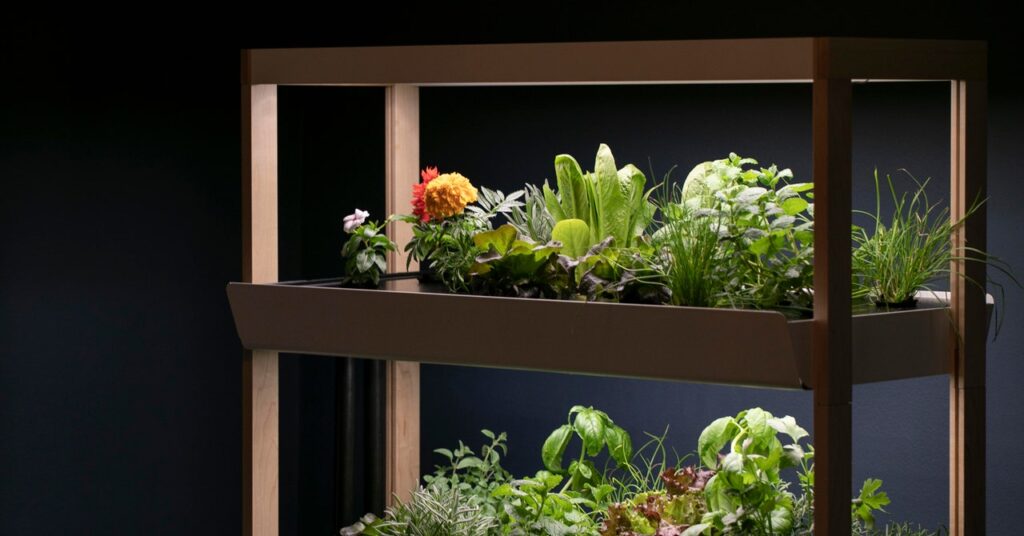Want to Grow Your Own Food? Try a Hydroponic Garden
Today’s home kits are stylish, smart, and easier to use than ever. Here’s how to get started….


A more artful approach to this is the forthcoming system made by Soilless. The company is the brainchild of Westen Johnson and Julie Joo, two graduates of the Rhode Island School of Design who first came up with the system while they were students. The design is simple: “It’s basically a big bag,” says Johnson. He explains that the bag consists of two layers that seal together similarly to a pool float, except instead of being inflated with air, it’s water. The vertical system can grow up to 23 plants. It hangs from a rod with an LED lighting fixture attached and looks like something you’d see hanging in a high-end loft. “It’s basically something that a normal person can afford and eat off of that’s like a living piece of art in your home,” says Johnson. When the system launches, it’ll retail for around $200.
There’s a System for Every Space
You don’t need a suburban house with ample space in order to make room for a hydroponic gardening system. In Atlanta, Greg Crafter founded Produce’d with the urban dweller in mind. “For an urbanite, space is very limited and comes at a premium So you want to utilize it and maximize it the best way you can,” says Crafter. People testing his system, which will launch in Atlanta this summer, keep it everywhere from their office to their living room.
If space is just too tight, there are tabletop options too. Rise has a personal garden system that grows 12 plants, but others include Edn which grows 10 plants, down to the petite Sprout by Aero Garden, which grows three plants (perfect for kitchen herbs). These smaller systems will probably not replace the produce you buy at the grocery store, but it’s a good way to supplement things like herbs.
Plants Are Good for Your Mental Health
Spending so much time at home has made us rethink our indoor spaces. We’re surrounded by square shapes and hard lines, which, whether we know it or not, has our brains longing for something akin to nature. It’s why more people are turning to biophilic (love of life) design, which focuses on incorporating nature into indoor spaces. “There are certain patterns and forms and sights and sounds that we encounter in the natural world that give us a positive physiological response,” explains Jennifer Bissonnette, the interim director of RISD’s Nature Lab. From the sound of running water to the aroma of basil, biophilic design elements can help reduce stress, lower blood pressure, and improve overall happiness, says Bissonnette.
While being a “plant parent” is a familiar Instagram trope, it applies to hydroponic plant owners too. Hydroponic systems don’t necessarily require the same amount of daily attention that a houseplant might, but engaging with these plants makes us feel connected to them. “I can’t stress that enough: It’s wonderful to have it in your living environment, but there’s something about engaging with another living thing and understanding that you’re in a relationship with it. I think that’s a marvelous thing for us,” says Bissonnette.
In a continuous loop of Zoom calls and reruns of The Office, these systems can also help you feel grounded. For Edmisten, checking on her plants is part of her daily routine. “It’s just a focused escape. The escape isn’t going somewhere else, it’s getting connected to where you are,” says Edmisten.
Tech Offers Faster, Foolproof Growing
Want produce quickly? Then hydroponic growing is definitely for you. “The plants grow twice as fast, because the nutrients are being supplied right to the roots. You can have a smaller garden and still produce a lot more food with it,” says Johnson.
As an added bonus, many of these systems connect with apps that make it harder to kill your plants. Rise, for example, has users enter which plants they’re growing on the app, and then it tracks the water levels, pH balance, and sets the lighting schedule. “We tell you when to do it, how to do it, how much. You really don’t need to be techie,” says Adams.
More Great WIRED Stories




